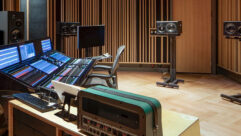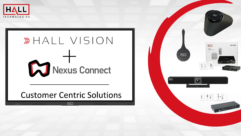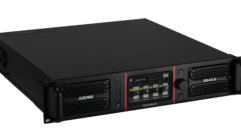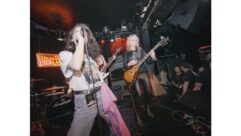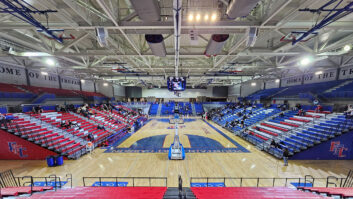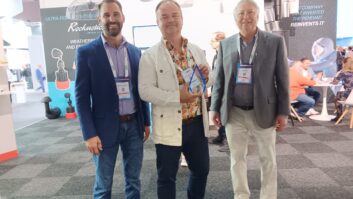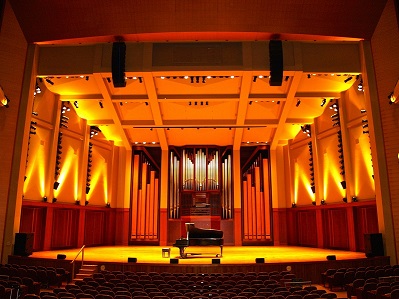
SEATTLE, WA — JUNE 2015: It’s natural for modern, landmark concert venue Benaroya Hall to be used for performances by the Seattle Symphony Orchestra. Specified by Jaffe Holden, it’s fitting that the audio infrastructure be serviced by a Seattle integrator, Carlson Audio Systems. But it’s just that little bit special that a key element of the audio system inventory is made by a Seattle manufacturer: Symetrix.
Benaroya Hall is a purpose-built home for the orchestra, but it also hosts lectures, jazz concerts, rock gigs and guest orchestras, including a recent visit by the London Symphony Orchestra. Its main space is officially called the S Mark Taper Foundation Auditorium, but Taper Auditorium is how everyone here knows it.
Classical, rock or jazz, the audio management of the Hall has been transformed. A re-drawn DSP infrastructure now facilitates an advanced networking solution: a hybrid Dante-CobraNet installation, sharing the common platform of Symetrix’s SymNet scalable audio routing and processing system.
Cat-5e cable was first pulled here in 2001, and later some Cat-6 was added. Around 2008 the DSP was upgraded to SymNet Express Cobra, just before the Dante audio protocol began to be accepted widely in system integration circles. More recently a speaker upgrade has replaced a system that had been flown and then struck every time it was used. This led to the current, permanently installed d&b audiotechnik V-Series system, which naturally invited a review of the DSP platform. Jaffe-Holden duly specified SymNet Edge, Symetrix’s powerful Dante-based suite of DSP tools. Coupled with a Soundcraft Vi6 console at FOH and a Lake LM44 I/O unit, it’s a configuration that affords all native and visiting productions complete analogue, AES or Dante access.
Mark Anderson, who has been Audio Manager at Benaroya Hall for three years and was formerly at Seattle’s 1920s Paramount Theatre, has witnessed a classic trajectory from analogue multicores and point source loudspeakers to modern DSP-driven systems and line arrays.
“The SymNet Edge units are being used as processors and outputs to the various amplifiers,” he explains, “so we go AES out to the d&b amps and also analogue out, in a few instances, for programme feeds and so on. This required a mix of analogue and digital SymNet I/O Option Cards for the SymNet Edge DSPs. Of course, it meant we didn’t have to replace the cabling.”
A total of three SymNet Edge units have been installed in two audio rooms. The first is at stage level and contains one DSP to feed the amplifiers for the stage subs and front-fills, with a short cable run to the monitor speakers; and the second is on the second storey containing the main d&b system amplifiers, fed by the remaining two SymNet Edge DSPs. Again, these rooms were already wired with Cat-5e – and Cat-6 – and the SymNet dimension was an easy upgrade.
Another Cat-6 run connects the FOH position with a legacy ‘under-balcony’-style system, actually serving three levels of side-tier seating. “We decided to keep the reliable SymNet CobraNet units for these areas,” adds Anderson, “eight speakers per tier, on both sides, necessitating 48 outputs. A little bit of latency for a delayed system like this is not an issue.”
Carlson Audio programmed the SymNet Composer files for the venue, while Anderson admits: “programming the Dante network was 100 times easier than programming the CobraNet section…” There are two legacy 8×8 DSP units, plus one BreakIn 12 and three BreakOut 12 units, alongside six ARC-series panels in various locations to access the legacy SymNet technology used to address dressing rooms, the lobby and other distributed programming. “Dante is reserved for the main left and right FOH system, front-fills, subs and a back-stage VOG mic – which goes analogue into the SymNet Edge unit and straight onto the Dante network,” Anderson explains. “For symphony events there isn’t always a sound engineer on call so, for show announcements, we use it to bypass the console and go directly to the network.
“Overall, the Symetrix installation provides a level of stability and user-friendliness that began with SymNet and keeps on improving as we upgrade the units. We’ve also upgraded the loudspeakers, so the whole experience has changed from sound quality to workflow: Dante, especially, has resulted in zero hiccups! Most of the gear is on 24/7, and it runs flawlessly.”
www.symetrix.co
www.carlson-audio.com
www.jaffeholden.com
www.benaroyahall.org
###
ABOUT SYMETRIX: Dedicated to making life sound better for almost 40 years.
With a current and broadly-based product portfolio that encompasses both open architecture (Edge, Radius 12×8 EX, Radius AEC) and fixed architecture (Jupiter, Zone Mix 761) solutions, Seattle, USA-based Symetrix is the global leader in digital audio signal processing. From a founding base in the studio and MI communities, Symetrix has emerged to take a defining role in commercial audio, its products now a default choice for large-scale installations in performance venues, sports arenas, educational establishments and many more. Benefiting from a worldwide distribution network that has seen its products specified in over 100 countries, Symetrix nonetheless continues to spearhead the entire design and build process from its Seattle HQ. The manufacturer is now enhancing its readiness for a new era of AV networking through its licensing partnership with Audinate, whose world-leading Dante media networking solution is fully integrated into the SymNet DSP platform.
For hi-res media files on the Symetrix product portfolio, please click here.


